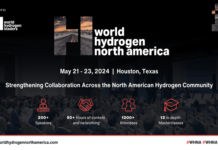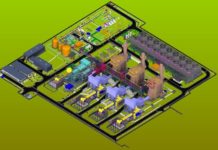The original contract for building the Majuba plant was awarded to Siemens, which is also supplying most of the instrumentation and control equipment. Other products came from many suppliers under the Siemens aegis. Thus, ABB Powertech provided the large transformers, while Steinmüller built the boilers. The Combustion Group is developing the new safety / monitoring software, for a Fireye Insight Scanner that will improve burner control.
MAJUBA PLANT MAKE-UP
Operating conditions mean that the boilers have flexible unit operation, high availability and high efficiency. They also have to be able to handle coals with high ash content. Slagging and fouling the furnace was a major concern in boiler design, and plant parts had to have low erosion rates. The boilers were built by Steinmüller, to a once-through evaporator design that allows short start-up times and a swift response to changing load demands. All heating surfaces are arranged in the first boiler pass. This allows:
Simpler arrangement of wall panels, connecting pipes and tube banks to help expansion and avoid stress
No welded connections of wall panels with different temperatures
Uniform flue gas flow pattern to help reduce tube erosion
The burners are in a three-burner staggered formation to reduce their heat release and hence minimise slagging. Each burner has its own oil gun to start up the pulverised fuel flame at low loads. Suspending the boiler from the top of the boiler house allows downward expansion. Even evaporation and heat take-up is provided by helical tubing in the furnace part of the evaporator.
Changes in technology over the plant’s extraordinarily long construction period meant that instrumentation and control for units four to six were far in advance of those for units one to three. The first three units all have discrete control rooms. The other units have a single control room, with an integrated control system supplied by Siemens.
SAFETY / MONITORING SOFTWARE
In 2004, Eskom announced co-operation with The Combustion Group to develop new software for the Fireye Insight Scanner, to be used in Majuba and other South African power stations. This new technology will improve the safety and monitor the behaviour of the burners. Burner performance can be optimised by better control and timely preventative maintenance of the burner system. This will in turn optimise capacity and maintenance costs.
COOLING
The first three units use direct air cooled condensers, while the others use wet cooling. Air cooling was originally selected because local water supplies are meagre, and dry cooling uses less than a fifth of the water used in wet cooling. The greater efficiency of wet cooled plants eventually made it more commercial to build a dam which increased the available water supply.
The plant was first proposed in the late 1970s, with firm equipment orders coming in 1982. Construction began in September 1983 but was stalled by the slump in economic growth in South Africa as well as economic sanctions. The electricity demand it was expected to supply never materialised. Although there is still little South African demand, Eskom has persisted with the project in the expectation of major exports to other parts of Southern Africa through the planned Southern Africa power pool.
South Africa already has its own, smaller, power pool. Power is sold into it via hourly Dutch auction to compete for the lowest price. As the Majuba plant was originally intended as a regular base-load supplier, it is hard for the plant to adjust to two-shift operation. Despite the original intention for continuous operation, the first three (completed) units have a start up rate of 97%. During 1998, the plant carried out 171 start ups. The first unit went on load in April 1986, designed and constructed by Concor. The fourth unit was commissioned in 1999. The fifth unit was commissioned in 2000, and the sixth unit in 2001. All six units at the plant were completed on time and within budget.
Much of the coal for the plant comes from the Witbank area mines, although there are a number of suppliers throughout the country. Originally, it came from the local Majuba colliery, which was specifically developed for the purpose. The Majuba colliery had to be shut in 1993. The need to import coal from outside the area pushes costs up, forcing the plant to compete in the higher priced peak time market. The coal also has a high (35%) ash content, which the boilers were specifically chosen to deal with.














































